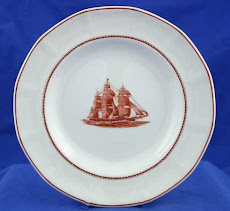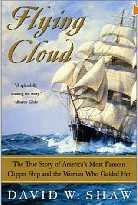The Clipper ship, Flying Cloud, was the masterpiece of Donald McKay, the foremost marine architect and shipbuilder of his time. She was launched in East Boston in 1851, just at the time of the California "Gold Rush", when travel and transport between East Coast ports and California was best undertaken by ship. The Flying Cloud acquired a reputation for sailing faster than any other ship of her time. On one record breaking occasion under command of Captain Josiah Creesy, she made the passage from New York to San Francisco in 88 days, 22½ hours, a feat never again achieved by a sailing vessel. The Flying Cloud could be seen racing into port before the wind, her acres of sail flashing in the sun. An ordinary sailing ship would lift her bows and plunge with the seas. But not this one. As her sleek, jet-black hull sliced through the swells, the only visible motion was the white curl at her bow and an occasional toss of spray. She seemed to skim the waves like a gigantic black and white bird. During her later years, she carried tea from China to London, making the passage from Foochow in 123 days. Like all of the fast clipper ships, her time came to a close as steam-powered vessels took over maritime commerce. Flying Cloud met an unfortunate end when she ran aground in 1874, could not be rescued, and was burned to salvage metalwork.
The engraving of the famous American Clipper Ship Flying Cloud presented here shows the ship as she surges forward in rolling seas towards an unknown port. She is heeling to leeward under full sails on a starboard beam reach. Many gulls are soaring off her starboard quarter. The artist, Burnell Poole, (1884-1933), spent years at sea in the North Atlantic with the U.S. Navy during WW One . Thirty years before our navy had combat artists, Poole recorded the warships in action. The U.S. Navy has less than two dozen works of art recording this period, and Poole's contributions number five. They were commissioned by E.I. Du Pont de Nemours and Company, and donated to the Naval Historical Foundation between 1928 and 1929 to commemorate the Navy’s participation in the war. These paintings, owned by the Navy Historical Foundation, are on exhibit in Washington, DC. Later, Poole turned to portraying the sea, by mastering the technique of engraving and dry-point. He earned a reputation as being the greatest American marine artists in those techniques. In 1922, he was being compared favorably to Englishman, Arthur Briscoe, 1873-1943. Poole also did engravings of many famous sailing yachts and ships and is applauded for his seascapes, navy and sailing ship works which all evidence the feelings of a true seaman. He engraved Flying Cloud in or about 1929.
Information extracted from www.landandsescollection.com which last sold the engraving in 2007.
Click here for images of come other ships appearing in the Flying Cloud pattern and their stories.
Monday, October 13, 2008
Subscribe to:
Post Comments (Atom)




No comments:
Post a Comment